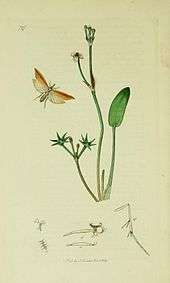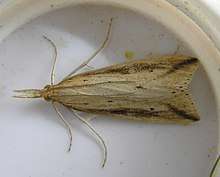Donacaula forficella
Donacaula forficella is a species of moth of the family Crambidae described by Carl Peter Thunberg in 1794. It is found in China (Heilongjiang),[1] Europe and South Africa.[2]

Illustration from John Curtis's British Entomology Volume 6
| Donacaula forficella | |
|---|---|
 | |
| Male | |
| Scientific classification | |
| Kingdom: | |
| Phylum: | |
| Class: | |
| Order: | |
| Family: | |
| Genus: | |
| Species: | D. forficella |
| Binomial name | |
| Donacaula forficella (Thunberg, 1794) | |
| Synonyms | |
| |
The wingspan is 25–30 mm. The forewings are yellow with a fuscous band along the upper margin of the cell and a fuscous spot at the lower angle of the cell. The moth flies from May to September depending on the location.
The larvae feed on Carex, Glyceria maxima and Phragmites.
References
- Chen, Fu-Qiang; Wu, Chun-Sheng (April 2014). "Taxonomic review of the subfamily Schoenobiinae (Lepidoptera: Pyraloidea: Crambidae) from China". Zoological Systematics. 39 (2): 163–208. doi:10.11865/zs20140201. Archived from the original on July 2, 2014.
- De Prins, J. & De Prins, W. (2017). "Donacaula forficella (Thunberg, 1794)". Afromoths. Retrieved March 1, 2018.
| Wikispecies has information related to Donacaula forficella |
| Wikimedia Commons has media related to Donacaula forficella. |
This article is issued from Wikipedia. The text is licensed under Creative Commons - Attribution - Sharealike. Additional terms may apply for the media files.